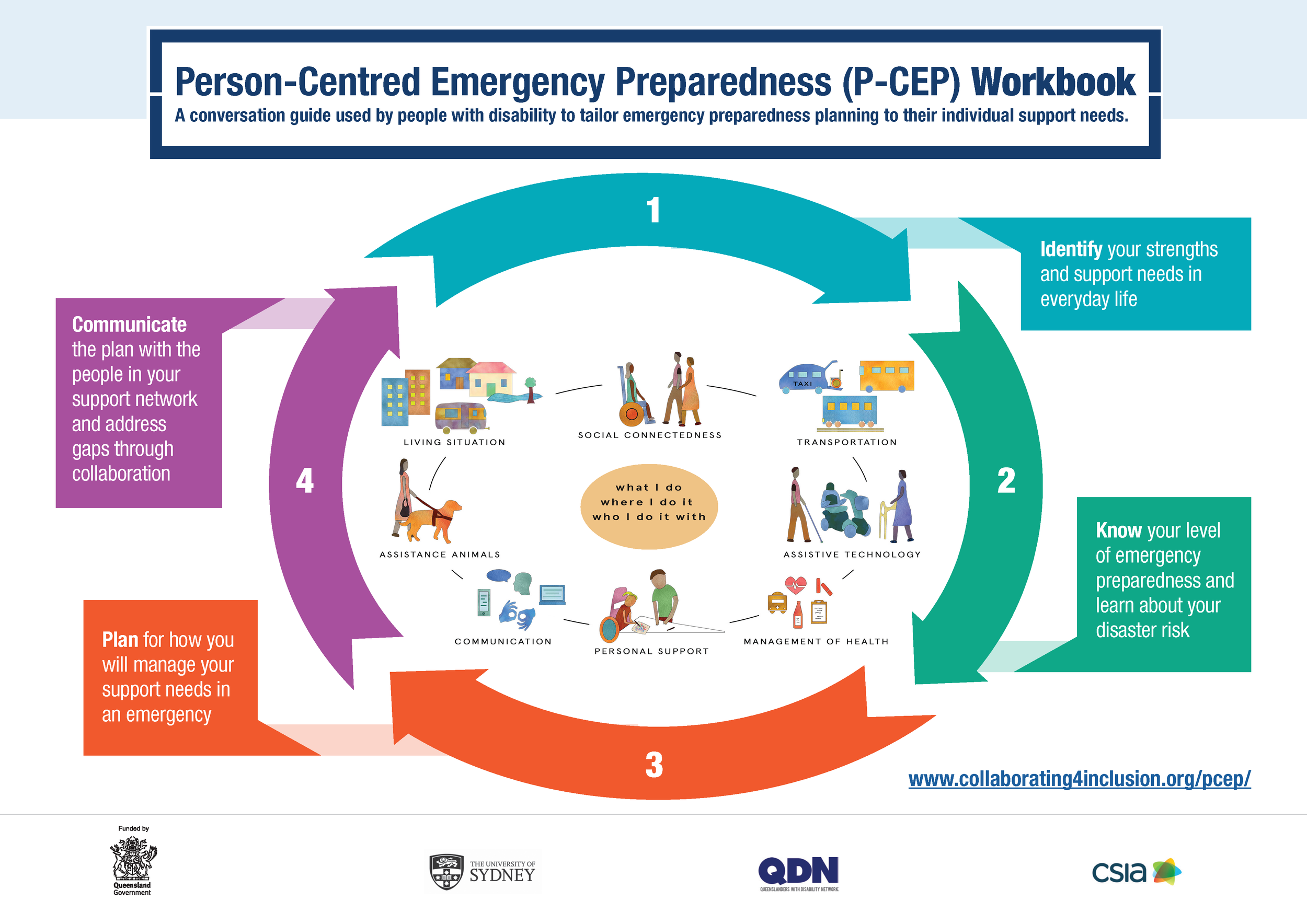What is P-CEP? Creating and updating your personal emergency plan
11 October 2024
In lead up to Resilient Kurilpa’s two P-CEP Workshops this Monday 14th and Monday 21st October, you might be asking, what is involved in the Person-Centred Emergency Preparedness process? Read ahead to learn how a P-CEP plan might support you to feel better prepared for the next flood.
You might have heard the saying “A fail to plan is a plan to fail”. The Person-Centred Emergency Preparedness (P-CEP) Plan is designed to prevent you from failing to cope in a disaster.
During previous floods in Kurilpa, some people with disabilities were caught unawares by rapidly rising flood water and the power being turned off without notice. They were trapped in their apartments because the lifts went out, unable to power wheelchairs and other equipment, and without refrigeration for food or medications. With better planning it is hoped that these situations can be avoided in future events.
Preparing for an emergency starts with a conversation, with family, friends, neighbours and support people, about what you would do in an emergency and how you would do it. The idea is to get you thinking about what you need in everyday life and then how you would manage those needs in an emergency situation if you were unable to dial 000 or emergency services weren’t able or delayed in getting to you.
Where to start
Start by thinking about the things you need and use in your everyday life.
What do I do?
Where do I do it?
Who do I do it with?
The process
The P-CEP workbook, which focuses on people with chronic health conditions or disabilities, has been co-designed and tested with people with disability.
It has 4 main steps:
Identify your strengths and support needs in everyday life.
Know you level of emergency preparedness and learn about your disaster risk.
Plan for how you will manage your support needs in an emergency.
Communicate the plan with the people in you support network and address gaps through collaboration.
What to consider
The key things that must be considered when planning for an emergency or disaster are:
Social connectedness
Do you have family, friends, neighbours or others with whom you are in frequent contact?
Personal Support
Who helps me with my activities of daily living, such as bathing, getting dressed, shopping, or preparing food?
Assistance animals
Do I have somewhere I can evacuate to that will allow me to bring my animal? How would I provide food for them? How will I manage their toileting?
Assistive Technology
Do you have machines that need charging, such as an electric wheelchair, or electric bed? How would you charge them if the electricity is cut off? Do you need back-up batteries or even a generator?
Living Situation
Do you live alone? How easily could you evacuate your home? Is there more than one accessible exit?
Transportation
How do I usually get around? Do I need an accessible taxi? Are family and/or friends able to transport me if needed?
Health Management
Do you take regular medication? Does it need refrigeration? How will you store it if the electricity goes out? Where are your prescriptions? If they are kept at your local pharmacy how will you get new supplies if the pharmacy is damaged or inaccessible? Where do you keep your health information?
Communication
How do you communicate with others? Do you have your emergency contact numbers somewhere easy to find? Do you have your phone handy or a wearable emergency device such as an emergency alarm button or Apple Watch? Who does it alert?
Preparing an emergency kit
It may be useful to have an emergency kit ready. There are two types: a kit for if you are stranded at home alone for an extended time, and a kit for if you are evacuated. Some of the things you may need are personal documents such as a birth certificate, prescriptions, medications, batteries and charging cords.
Testing your preparedness
It may be a good idea to do a practice run to get an idea of what you might need.
Make sure you’re aware of possible risks especially if you live close to the river or in an area that may be flooded by stormwater backup. Get to know where flooding has occurred in the past and whether your home could be either flooded or cut off.
During an event, keep up-to-date by listening to emergency announcements, such as on your local ABC Radio station (e.g., ABC Brisbane 612) and heed warnings to prepare or evacuate. Let your support people know in good time if you will need their help and be aware that emergency services may not have the resources to help everyone all at once.
In preparing for an emergency, you also need to think ahead to the time after the event. This may be the most important thing because you may be away from your home for weeks or even months.
Be an active participant in your emergency plan; only you can know your needs and how you want your situation managed.
And don’t forget to review your plan regularly to keep it up to date.
Rose Lane is a freelance writer who has lived in Brisbane since 1985 and in 4101 since 2019. She has been a regular contributor to The Westender and was a Community Correspondent with ABC Radio Brisbane from 2014-2016. Her writing has appeared in The Guardian, The Big Issue, New Matilda and other publications.


